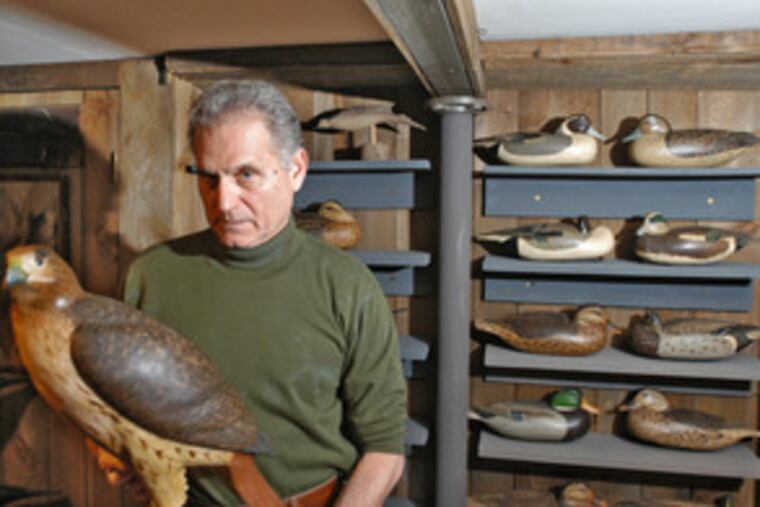Decoy carvers keep their art form afloat
Bob White sprays a bit of salt over the partridge he bagged a few days before. It will soon be lunchtime, the middle of a perfect day - a little reading, some schmoozing, a bit of carving for the turkey decoy he will use later in the month.

Bob White sprays a bit of salt over the partridge he bagged a few days before. It will soon be lunchtime, the middle of a perfect day - a little reading, some schmoozing, a bit of carving for the turkey decoy he will use later in the month.
"I like to hunt, and I keep and cook everything I shoot," White said. "I grew up on the Delaware River and never really left it. I've hunted and fished and trapped and carved birds for pretty much my whole life."
White, 67, of Tullytown, started carving decoys about 60 years ago, when he was growing up in the Chambersburg section of Trenton. Then it was so that his father and he and his friends could use them for hunting. He claims to have been the first full-time decoy carver in the Philadelphia area, having sold in the early 1980s the flower shop, Livingni Florists, that he and his wife, Pauline, ran for 23 years. It was a wild chance, but it ended up making him a legend.
"Bob's the last of the old school, the man who has made decoy-carving an art," said Sean Sutton, himself a noted decoy-carver out of Paulsboro. "When you buy a Bob White decoy, you are buying the history of hunting and carving on the Delaware River."
A White duck-carving can bring $3,000, especially since he rarely does any for sale these days.
"I retired two years ago so I could do more hunting and fishing and whatever I wanted to. Oh, I still do a lot for myself," said White, showing off the big hen turkey he intends to use to lure the one wild turkey due him on his license. "Sometimes you just have to do things for yourself and let the part about making money go."
Both White and Sutton say decoy carving has gone from a practical hunting tool to a craft to folk art in the last four decades. White, the historian, points to John Blair and John English, who both lived in Philadelphia and sold decoys part-time from the late 1860s through the early part of the 20th century. They made a distinctive bird - skinny and light, with cut wings and carved tails. White said that decoys elsewhere and earlier, especially those made by American Indians, were crude and not true to the way a bird looked.
Still, Blair and English mostly worked other jobs. Hunters, at least through the 1950s and 1960s, pretty much made their own decoys.
"Then the art folks started discovering us," said White. He said he likes the older decoys he made better than the "art" ones. "They were light and durable and usable. What I did later were good in other ways. The colors were perfect and the carvings were true, but they wouldn't stand up very long if you tried to put them in a pond and hunt over them."
Sutton, 39, is quitting his heavy-machine operator's job this spring and going into carving full time, having waited for his wife, Julia, to finish her nursing degree. His basement shop in his Delaware Avenue home, not far from the river, contains little heavy machinery - just a few power saws. Even those he does not use much.
"The art of this is in carving and painting," said Sutton, who gets between $600 and $1,200 for a pair of new ducks. Carvers generally do them in pairs - male and female. Neither White nor Sutton has ever advertised. Sutton does go to some trade shows, but mostly just to keep his name in circulation. "It is a community where people find out about you," he said of decoy carving.
Sutton's birds are detailed and have intricate carvings, while White's tend to be simpler. Both use cedar from a supplier in Maine who kiln-dries it. "You could use Jersey cedar," said Sutton, "but after a year, sometimes the sap bleeds out and will ruin the paint." They prefer oil-based paint, which tends to hold the detail better.
White said that when he was a boy, he and his older brother, Jim, used to strip the cork out of old industrial refrigerators at the Peter Cracker dump near their house, then collect pine from fruit boxes the A&P grocery would throw out. He would laminate the pine strips with standard glue and use the cork for heads.
"Sometimes I wish I still had some of them. With the rage for folk art, who knows what they might bring?" he said with a laugh. He goes to shows now and buys and resells decoys, though he prizes an old John English black duck he keeps with others in his basement collection. On occasion, though, he runs into an early Bob White on the antiques circuit.
"Yes, I've bought my old ducks for far more than I originally sold them for," he said. "Then I sell them again for more than that. It's supply and demand, and if people like a Bob White decoy, then I am happy to make a little extra reselling one."